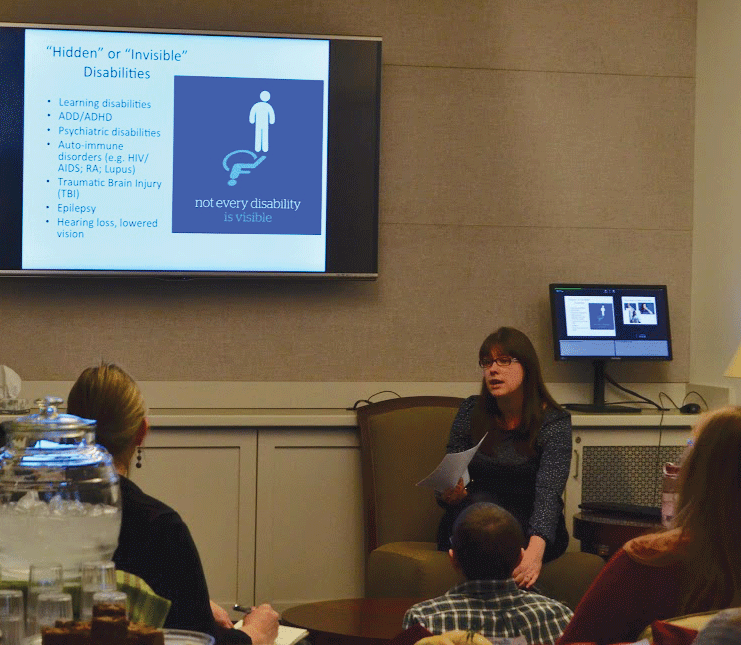Brown Bag Unpacks Stigma and Assumptions of “Hidden Disabilities”
On Monday, February 1, “Colgate Conversations” hosted the second installment of the Brown Bag series, titled “Seeing is Believing? Hidden Disabilities at College.” Based on the principles of Intergroup Dialogue, this Brown Bag series was created with the hope of facilitating conversations about race, diversity and inclusivity on campus.
The discussion addressed various preconceived notions about disabilities. Visiting Assistant Professor in the Educational Studies Department Ashley Taylor opened the lecture by defining hidden disabilities as disorders that are not easily detectable at first glance. These hidden disabilities include, but are not limited to, learning disabilities, ADD/ADHD, psychiatric disabilities, autoimmune disorders, traumatic brain injuries, epilepsy, hearing loss and lowered vision.
Taylor drew the audience’s attention to common assumptions that many people make about vision. She explained that it was not crucial to see the presentation behind her, as she would be describing the images on the screen.
“It may seem strange to people, but I can’t presume that everyone in my audience can see the PowerPoint,” Taylor said. “I can’t presume anything about your visual abilities.”
Taylor addressed the fact that society privileges visible disabilities over hidden disabilities, as they are often more evident. If a person sees someone in a wheelchair, that person will often assume they need help. However, if a person has an invisible disability, such as a learning disability, their claim that they have a disability may be met with skepticism when requesting special accommodations in the classroom, as they appear to be able-bodied and not disabled.
“What I really want is for us to be challenging our thinking a little bit more about what it means to think about having a disability in a college, but also to get us thinking about the assumptions we carry into the conversation,” Taylor said.
Taylor argued that because many people have been conditioned to perceive someone as disabled if it is physical, someone with a hidden disability often “passes” as normal. Taylor argued that because they can hide their disability, they may resist disclosing it. This process has been coined as “coming out,” as the stigma attached to hidden disorders may be something certain disabled people will do anything to avoid.
A person can be viewed differently by their peers, experience emotional trauma while disclosing or be seen as less capable or competent in the classroom if they choose to come out.
“Hidden disability gives you the privilege to pass but it may also impact you in deeply negative ways,” Taylor said.
As part of the process of erasing the stigma attached to hidden disabilities, Taylor argued that one must first address the primary assumptions attached to them.
The first assumption is that disabilities are static conditions. Taylor said this frames disabilities that are episodic or triggered by certain events or activities as less legitimate than those that are chronic.
Secondly, there is an assumption that disabilities are easy to prove. This is an obstacle frequently met when requesting help in the classroom. In order to receive a diagnosis from a doctor, someone may have to go through a tedious process of tests before they can be considered disabled.
The last assumption that Taylor addressed is that it is unfair to give someone special treatment in the classroom. Taylor acknowledged that this is a constant
challenge for professors. Many professors are confronted by a challenging predicament: how do I maintain high academic standards while making accommodations for students who truly need them?
The key, Taylor said, is to not only challenge our ideas about normalcy and disabilities, but to change how we perceive disabilities overall. As most courses emphasize time and time management, Taylor argues that students are typically measured on how fast they can think and not on what they can actually do.
Typically, accommodations made for students with disabilities are viewed by some critical classmates as an advantage that only students with disabilities get to enjoy. However, Taylor argues that granting someone more time for a test or permitting them to take notes on a computer allows them to perform to the best of their ability. Taylor said we need to shift the paradigm so that all students will view special accommodations in the classroom simply as an arrangement made to ensure the success of fellow students.
“I hope that what this does is make professors more aware of hidden disabilities and make the students more aware of the resources available,” senior Lindsay Appleman said, regarding making requests for special accommodations. “It starts with self-advocacy but then it turns into the school taking care of it for you.”
Senior Sylvie Lauzon echoed the need to talk more about this issue. “I thought it was a great conversation and more conversations like this need to be held on this campus.”
The next “Colgate Conversations” Brown Bag is “Interrupting Islamophobia” on Monday, February 8 at 12:00 p.m. in Lawrence 305.







